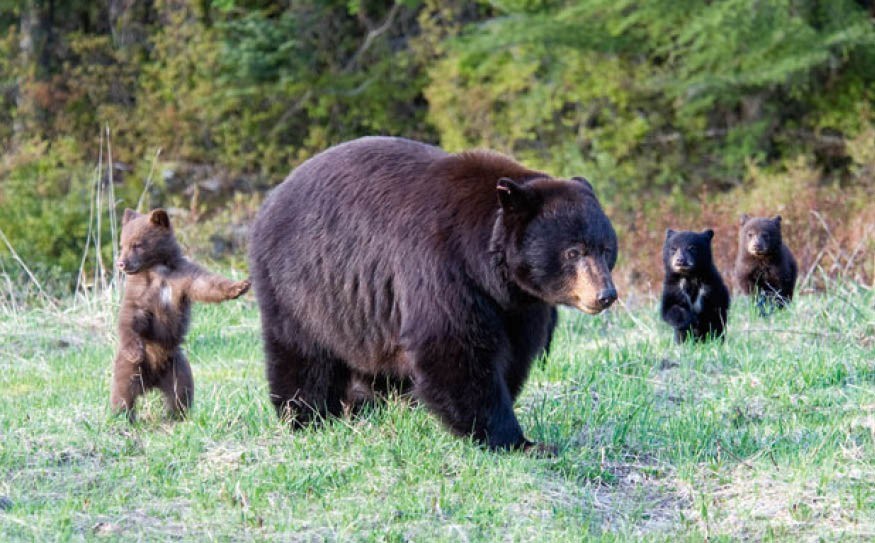It was 3:30 in the morning. The acrid smell of gunpowder lingered in the air, mixed with the sweet, sickening smell of bear blood that oozed down the driveway of the home. The blood looked black illuminated in the glow of the porch light and the wavering beams of our flashlights. The bear was black too — big, black, and now, lifeless.
I wish that it hadn't ended up this way; the bear's final agonized writhing in the driveway, the smoking shotgun, my hands shaking from the rush of adrenaline and emotion. Unfortunately, neither of us had much say in the matter. This tragic end had been decided long ago.
This is part of my job as a district wildlife manager, a part that I despise. Dozens of wildlife officers must perform this same awful duty every year throughout Colorado. Some bears, no doubt, must be killed. But many of these incidents can be avoided if people used some common sense.
I knew this end would come, long before he did. I met him three years ago, when he was just a cub. He was trapped in a dumpster that his mother led him into to eat. I lifted him out with a snare pole and let him go — he was freed from the confines of the dumpster, but he couldn't escape his fate — the end of his story was already being written.
Our paths crossed several times over the next couple of years. He'd pull down bird feeders and I'd give out "Living with Bears" brochures to the homeowners. A month later I'd see the birdfeeders hung out again, right against the picture window. The homeowners would report the bears "aggressive behavior," how it stood and looked in their window — how it wasn't frightened of people, even as they stood just on the other side of the pane and took pictures of it.
I knew what the bear must have thought, too. Four hours picking berries one by one, versus four minutes munching down birdseed for the same caloric gain. The goofy looking humans on the other side of the glass had never bothered him, never told him he was trespassing, never tried to stop him, never tried to help him by permanently taking down the birdfeeders. Plainly, that meant the birdseed was his. This side of the window became his turf, not theirs.
Later we hashed it out over trashcans and dumpsters. He was a good-sized bear by now, handsome and black as the night. In the dark, he was a mere shadow, or more so, a complete absence of light. He was big enough to upend a dumpster if he felt like it, but more often than not he just took advantage of the myriad of trash cans left casually, thoughtlessly, out on the street. The complaints would come, and the garbage can owners would all cite the same solution — get rid of the bear.
No one wanted him killed, of course. After all, he had only gotten into their garbage. They just wanted him gone; taken away, moved somewhere else so that they would not have to make any changes in the way they did business. It was convenient for them to put their trash out the night before pick-up. Bear proof trash cans cost $200 or more. They'd lived there for five years and never had a problem before. I'd preach the gospel of living with wildlife, wishing it wasn't falling on deaf ears, but knowing through experience that it most likely was. I'd give my advice and a colour brochure on how to avoid conflicts and take my leave, knowing that the ultimate, unfortunate fate of the bear was getting nearer with each apathetic encounter.
Then finally one night, inevitably, the old bruin took it too far. Lured in by a chain of unwitting and apathetic homeowners, urged on by a string of bountiful successes, he was at last coaxed over the line. It all came down with frustrating irony, not even the backdrop seemed right: a well kept, rustically adorned summer home in a forested subdivision. Most ironically though, the homeowners who were his final victims did not feed birds, or leave garbage cans on the street, or feed their pets outside or anything else to draw him in. They did nothing at all to encourage this bloody outcome, but suffered the ugly consequences of their neighbour's neglect and sloth.
In the end the bear, driven by biology and emboldened by experience, broke through the kitchen window, only to be run back out by the home's rightful occupants. But the bear was determined now, and lingered, and after a while tried again to hijack the house. A second roust, more confrontational than the first that involved thrown objects and much yelling put the bear out again. But he wasn't going to leave until he got what he wanted.
This is when I met this bear for the last time. Our final encounter, considerably less pleasant for both of us over any previous ones, involved two slugs fired from my 12-gauge shotgun into his chest. As he gasped his last breath and his blood oozed out onto the driveway, I only wished that all those people we had met along the way could have been there to share this moment with us. Maybe then... well...
Chris Parmeter is a district wildlife manager for Colorado Parks and Wildlife in the Gunnison Basin.




